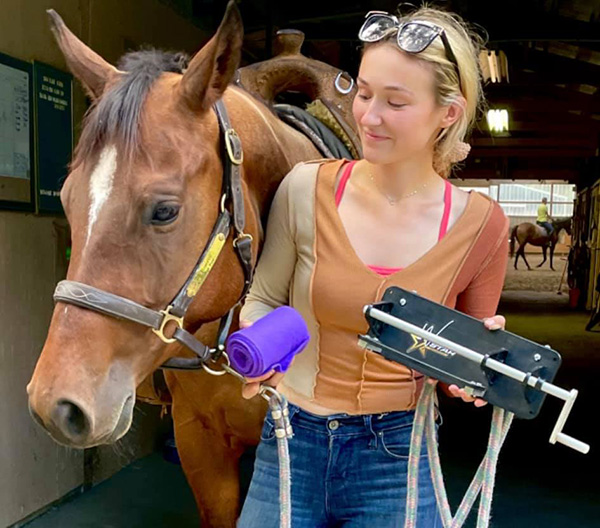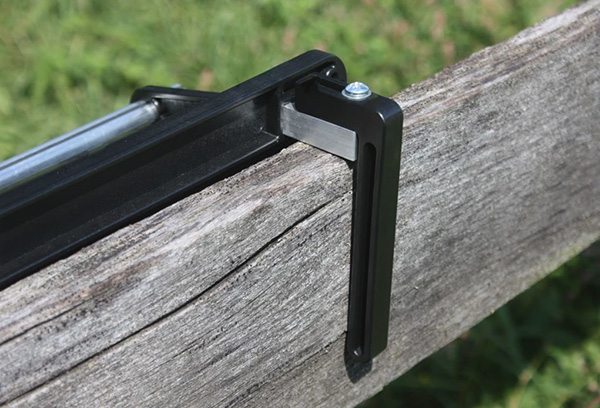Create What You Can’t Have- Equine Inventor Cat Guenther

By: Brittany Bevis
For AQHA competitor, Cat Guenther, the concept of failure is just a social construct. In her opinion, “failure is just another word for learning.” She has taken this thoughtful approach and applied it to every area of her life, including horse show competition, her career, and her passion as an entrepreneurial inventor.
“It all began when I was eight years old, and I discovered my love for horses,” Cat says. “I’m grateful every day to have found my passion so early in life. I took lessons for a long time on a Palomino Quarter Horse mare named Twist and eventually had my own horse at 10 years old. I remember working at the barn for years, dusting cobwebs, mucking stalls, just doing anything and everything I could do be in a barn with the horses.”
Cat began competing in open shows and on the AQHA circuit when she was 13 years old. It took quite a long time to find her ideal show partner and that day happened in June of 2018 when she met Zippos Kat Man Do. She and Teddy started competing at major events like the Quarter Horse Congress and AQHA Youth World Show. “We made memories to last a lifetime,” she says. “Teddy taught me many life lessons and made me both the person and equestrian I am today. Sadly, he passed away this past summer due to colic complications. However, his memory lives on in each day and in everything I do.”
Her new show partner is Legally Blondie, aka “Elle,” a three-year-old bay mare. She will be competing in amateur all-around events in 2022 under the guidance of Reid Thomas Performance Horses.
But this story isn’t about Cat’s history as an equestrian or even her accomplishments in the show pen. In addition to being a non-pro competitor, Cat is an inventor.

A first prototype of the WrapStar.
“Thinking back, I’ve always had that little spark for entrepreneurial ventures,” she says. “I believe the best way to learn is through doing rather than talking. At 13 years old, I started ‘Behind the Bit Show Clothing,’ which focused on show clothing sales, consignments, and rentals. I wanted to bring beautiful, affordable, horse show clothing options to the everyday exhibitor. Behind the Bit grows by the day, which helps financially support my horse habits. It has been an amazing journey learning the ins and outs of sales through actual experience, rather than reading about it in a book.”
“Most of the entrepreneurial ventures I’ve done in the past focus around the equestrian industry. I dyed show tack for a while, made ads for people, and even tried to dabble in equine photography at the age of ten years old. A for effort?”
But Cat’s latest venture is the result of a problem that she couldn’t find a solution for, and she decided to do something about it. “About a year ago, I was at the barn and was extremely frustrated at the amount of polo wraps I had to re-roll. I absolutely dread rolling them by hand. It always was, “Oh, I will do them tomorrow,” and by the time I knew it, there were over 20 wraps sprawled out in my tack box.”
 “I thought that there had to be a better way to do this. I researched and was surprised at the products that appeared. I tried a couple cheap options, but those products fell apart quicker than a blink of an eye, and they weren’t portable. Portability was a major factor, because I know how much equestrians travel to different venues. All the other options were either extremely heavy to transport or they were built with weak materials.”
“I thought that there had to be a better way to do this. I researched and was surprised at the products that appeared. I tried a couple cheap options, but those products fell apart quicker than a blink of an eye, and they weren’t portable. Portability was a major factor, because I know how much equestrians travel to different venues. All the other options were either extremely heavy to transport or they were built with weak materials.”
This led to Cat sitting in her room late one night with a pen and pad of paper sketching out drawings of a new polo wrap device- the WrapStar. “I wasn’t sure if anything would ever come of it, but I thought it was worth some sketching. After that, I connected with some horsey friends, who pushed me to take the concept further. One thing led to another and here we are!”
 Cat explains that the design process of creating an invention takes the most time. “When you buy a product off the internet, or at a store, it doesn’t usually cross your mind what goes into the design formation for that item. I started drawing out the very basic ideas for WrapStar in a notebook in my room. I was persistent and eventually had more professional drawings done after attempting to explain my rough sketches. I’m not artistically inclined. Then, I brought the best sketches to my toolmaker, and he developed a CAD (Computer Animated Design) of the product.”
Cat explains that the design process of creating an invention takes the most time. “When you buy a product off the internet, or at a store, it doesn’t usually cross your mind what goes into the design formation for that item. I started drawing out the very basic ideas for WrapStar in a notebook in my room. I was persistent and eventually had more professional drawings done after attempting to explain my rough sketches. I’m not artistically inclined. Then, I brought the best sketches to my toolmaker, and he developed a CAD (Computer Animated Design) of the product.”
The WrapStar is a portable device that helps equestrians rewrap polos, bandages, and standing wraps with ease. It’s 100% made in the USA. “The ‘U’ bar has a slot through the middle that guides the wrap as it’s rolled and helps create a very tight wrap,” Cat says. “Equestrians know that a tight wrap is much easier to apply to a horse’s leg, as well as it provides more support to the leg. That’s why I designed WrapStar to ensure a tight roll by lightly applying pressure through the U bar. This ensures a tight, crisp wrap each time. There are hooks on the backplate of the device that adjusts to various stall widths. There is also an option to mount the product to a wall with four screw holes.”
 Every minute detail of the product needed to be considered before the design could be sent to production. In total, it took seven months until Cat could hold the WrapStar in her hand.
Every minute detail of the product needed to be considered before the design could be sent to production. In total, it took seven months until Cat could hold the WrapStar in her hand.
“This required many meetings where we talked about the functionality and physical design of the product. I loved the process. I spoke with a local toolmaker about my ideas, and he was very excited to work with me. We encountered many difficulties along the way. As you know, virtually nothing goes as planned. During production, decisions needed to be made about changing the design and material aspects. While these decisions were stressful and often time sensitive, I believe these tweaks allowed WrapStar to become an even better product.”
An important part of designing a completely new product is determining whether it can be protected by a patent. “My attorney filed an application with the US patent office, and the applications are awaiting examination. Therefore, WrapStar is patent-pending. The whole process to getting issued a patent can take up to several years. It’s quite a lengthy endeavor.”
Now that she has seen her first invention go from concept to design to product, Cat is excited to work on additional projects. “I carry around a notebook with me and jot down ideas 24/7,” she says. “Equine Redefined has a few amazing concepts in the works. We’re partnering with other innovative equestrians and businesses as a platform to sell their products. This is only the beginning, so I’m excited to see what the future holds.”
For fellow equestrians, who might also have the inventor bug, Cat has some advice. “Act, even if you fail at first. To me, failure is a social construct. Failing is only another word for learning. So, start drawing. I’m the absolute worst artist, but I sketched out one of my ideas, and it eventually became a real, physical product. Even if you don’t develop the concept into a product, writing down your ideas is always helpful so you can see your thought process on paper.”
If you have a great story to share with EquineChronicle.com, email B.Bevis@EquineChronicle.com.










